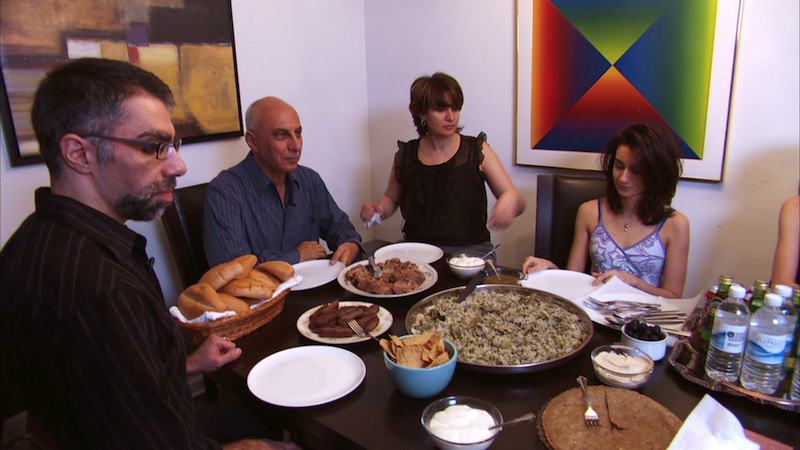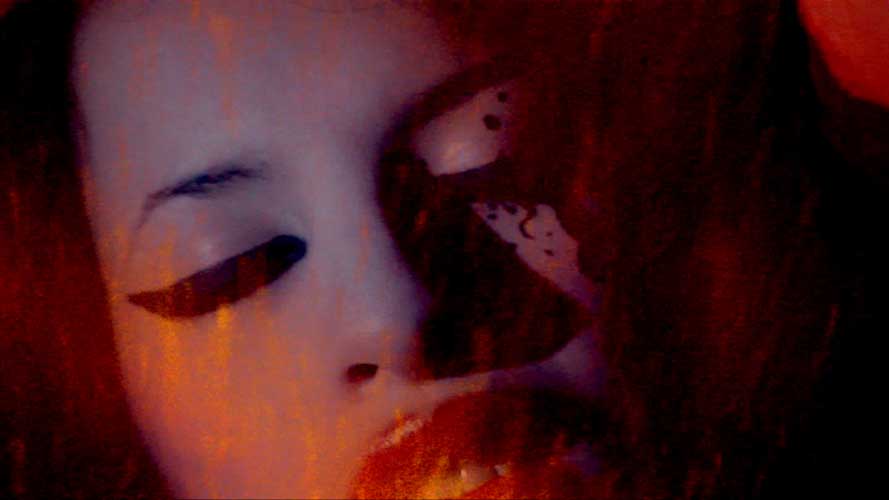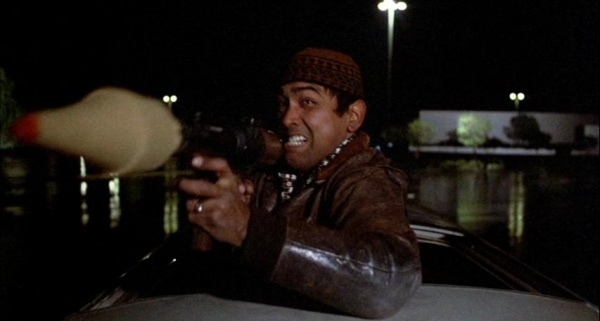
Alshaibi (far left) in American Arab
Last night the 21st Chicago Underground Film Festival closed with Usama Alshaibi’s American Arab, a documentary profile of various Arab immigrants and the American-born children of Arab parents. It’s the former Chicagoan’s second personal documentary (after Nice Bombs, from 2006), as well as the least confrontational work this longtime provocateur has made. (For more on his development, check out the conversation we posted last week between Alshaibi and local filmmaker Carlos Jiménez Flores.) Where his other movies have played in underground film festivals, Alshaibi hopes for American Arab to screen in community centers and high school classrooms. I spoke with Alshaibi last week to learn how changes in venue and the makeup of his audience shape how he regards his movies. Our conversation soon turned to spectatorship in general, as we discussed, on the one hand, how movie audiences can provide independent filmmakers with a sense of community and, on the other, how audiences assimilate images in mainstream entertainment.
Ben Sachs: How many pieces have you presented at CUFF at this point?
Usama Alshaibi: My first thing at CUFF was a music video I showed in the late 90s. The following year, I made a short film called Dance Habibi Dance. That was sort of my breakout—I made it immediately after I finished at Columbia College. I’ve premiered all my other features and a lot of my shorts there. It became a home for me, a place where I knew people would be receptive to what I was doing. The screenings are awesome, the parties are fabulous. So it’s a place I want to keep coming back to. [It’s] close to my sensibilities.
That makes sense. Your narrative movies often deal with subcultural communities.
When I decided to get into film, I was inspired by the cinema of transgression. I liked the stuff that Richard Kern was doing in New York, also Nick Zedd and Lydia Lunch. I would reach for these underground films . . . but at Columbia, there was a push to make more conventional types of films. I remember visiting film crews and being turned off and overwhelmed by the amount of people. It seemed like too much for me. I liked just having a camera and a couple actors, having the crew act in the movie. That’s just who I am, and the festival reflects that.
You made American Arab with Kartemquin Films. This has got to be the most mainstream thing you’ve done, no?
It is. It’s a big leap from my last feature film, Profane. Have you seen that?
I reviewed that when it played at CUFF a few years ago.
That’s right. You called it a bargain-basement version of Enter the Void, which I really appreciated. That was a high compliment to me.
I was afraid you’d take it as an insult.
No, no! Enter the Void cost so much money, but you thought we were able to get at the same stuff for very little! I funded the whole thing, I shot it, I did everything. Later it won the best feature prize at the Boston Underground Film Festival—which just rejected American Arab, incidentally. So you’re right—it is a more mainstream film.
As for Kartemquin, I’ve always admired them. One of the first movies I saw when I came to Chicago was Hoop Dreams, and I was blown away by it. I remember bumping into [Kartemquin cofounder] Gordon Quinn in the South Loop when he was shooting The New Americans. I just went up to him and said, “Hey, I want to talk to you.” That was pretty much my only interaction with him before making American Arab. [laughs]

I knew that I was working with Kartemquin and that they have a particular philosophy about filmmaking. They have a clear idea of social practice, connection to the community, and how films can help people. These are very noble goals, so it was an honor to attach myself to an organization like that. Now, you said this was a mainstream film . . .
In that you made it with a more professional production outfit than you usually work with.
That’s definitely true. I think that professional filmmakers have to cast a wide net with certain films. I can make art films and know that there’s a specific audience for it. But this movie is something I want everybody and their neighbor to see. The message is large, and it’s clear. So I think that was the important thing with this, being able to communicate clearly. Because I do think it’s getting at something important.
It’s giving voice to people who have been marginalized—and when they are presented in mainstream American media, it’s rarely from their perspective. Also since 9/11, bigotry towards Arabs has increased noticeably in this country. Certainly that’s influenced depictions of Arabs in the media—regardless of whether the depiction is positive or negative, it’s still responding to the zeitgeist.
I agree that things changed after 9/11 and that fear and paranoia regarding Arabs got pumped up. But, as I argue in the film, that had existed before, just in a different form. When I was a kid, it was typical orientalist stuff—that we have flying carpets and camels and all this stuff.
You have that montage in American Arab of stereotypical Arabs in Hollywood movies, mainly from the 70s and 80s.
The big one was Back to the Future, because that’s a great, iconic film. I was a teenager in the 80s, and I saw it in a theater. I liked the film, but . . . every time I’d watch films with friends and these scenes came up with crazy, hysterical, terrorist Arabs, I’d cringe in my seat. I’d try to block them out of the films in my head, but they were always there.


These things affect people. As much as we might want to deny it, when conventional, Hollywood movies keep giving us these images of bad-guy Arabs, they get normalized. So when a crime is committed by an Arab [in real life], all those images come back to people, because they’ve seen nothing else. They don’t think of Steve Jobs when they hear about an Arab-American—they think of the wild, bearded guy with a turban and a gun.
One of the things I’m doing [in American Arab] is pointing out this way of thinking about minorities in America. Every minority group or ethnic group has been subject to it, and I want to point out that it’s happening again. We need to call it out when we see it.
At the same time, the movie doesn’t feel confrontational. It feels like the start of a conversation, rather than a provocation. I was a little surprised by that, actually, having seen some of your other movies.
If someone in the audience is on the fence about Arab-Americans and my movie pisses him off, then I don’t think the movie is successful. And yeah, I’ve made a lot of provocative shorts and things that are a little more aggressive, but I’m not really interested in that anymore. There are discussions that take place within the Arab community, and then there’s a greater conversation [in American society]. I’m trying to bring these two together—you know, going in the Kartemquin spirit of [starting] dialogue.
Do you say you’re not interested in provoking an audience with regards to this movie or that you’re done with that indefinitely?
Well, I don’t necessarily try to make transgressive cinema—it’s just in my blood. [laughs] I have certain obsessions and dreams and nightmares that I keep returning to. But with this film, there’s a little more of a social message. There’s also a diary element and humor and documentary elements . . . I look at it as a way to introduce people whom I admire [to audiences].
A lot of the people in American Arab remind me of my family or my friends or even myself. And I think about young people growing up [in America] now who are refugees from Iraq, Syria, or other Middle Eastern countries . . . I’m hoping they can catch this film and not feel so alone. That’s why I want to make it as “rated G” as possible—well, maybe not G-rated, because there’s a lot of swearing. But I was thinking of this as something that could be shown in high schools and community centers. I want other young [Arab-Americans] out there to see it and know that they’re OK. There’s a lot of hate being thrown at them because of who they are or where they come from, and I’m saying, “Don’t worry about it. You can be yourself in America. That isAmerica.”
Do you see yourself making more movies that could be shown in community centers?
Probably not. I’m interested in these themes, but I pretty much make the kinds of films that I like. And a film like Profane, I’m not going to bother showing that to a certain community—it’s not going to be helpful to them. But that movie was something I really wanted to do. And so, it’s played at sex workers’ film festivals [festivals of films by and about sex workers] and underground film festivals.
This documentary was unique for me in that it was a collaboration with Kartemquin. If I make another movie with them, it will probably resemble this. But for now, I’m happy with it. It’s the big statement.
By Ben Sachs (Monday, April 7, 2014)
source: http://www.chicagoreader.com/Bleader/archives/2014/04/07/watching-the-audience-with-usama-alshaibi